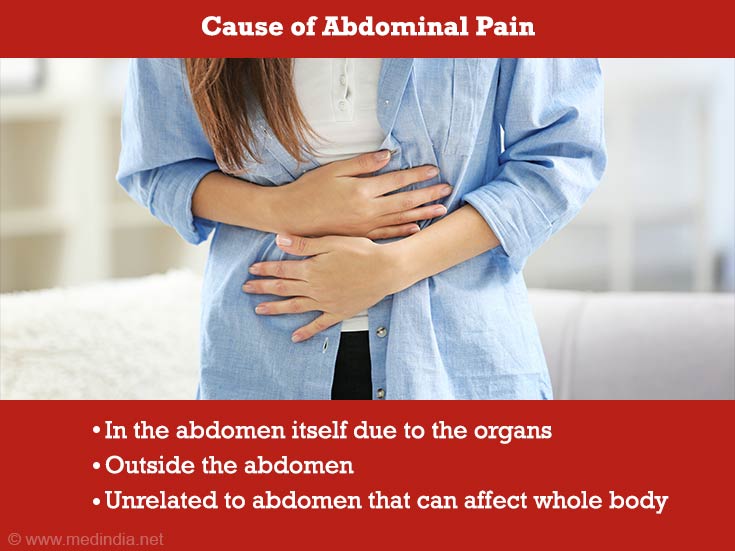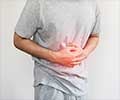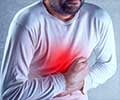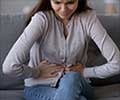- Clinical Methods: The History, Physical, and Laboratory Examinations. 3rd edition. - (https://www.ncbi.nlm.nih.gov/books/NBK412/)
- The Role of Noncontrast CT in the Evaluation of Surgical Abdomen Patients - (https://pubmed.ncbi.nlm.nih.gov/29981641/)
- Clinical Methods: The History, Physical, and Laboratory Examinations - (https://pubmed.ncbi.nlm.nih.gov/21250045/)
- An Atlas of Pain Patterns. Sites and behavior of Pain in Certain Common Disseases of the Upper Abdomen - (https://pubs.asahq.org/anesthesiology/article/22/5/860/16011/An-Atlas-of-Pain-Patterns-Sites-and-behavior-of)
About
Pain in the abdomen could occur due to multiple causes – local causes within the abdomen, causes outside the abdomen, and causes affecting the whole body. Pain originating from the abdomen could arise from the different abdominal organs like liver, gall bladder, spleen, stomach, intestines and pancreas, or from the peritoneum (the lining of various organs and the inner wall of the abdomen), or abdominal wall.
Pain varies in intensity, location, quality and duration depending on the cause. Thus, a careful history is often essential to diagnose the cause of pain. A brief overview of different causes of abdominal pain along with their types is presented below:
Common Causes of Acute Pain of Abdomen
Pain can be acute or chronic and persistent for a longer period. Common causes of an acute abdomen include appendicitis, cholecystitis, pancreatitis, and diverticulitis. If a hollow organ ruptures, it spills its content into the abdominal cavity and causes acute peritonitis causing generalized acute pain(1✔ ✔Trusted Source
Clinical Methods: The History, Physical, and Laboratory Examinations. 3rd edition.
Go to source).
Urinary acute causes include a stone blocking the kidney or ureter or the bladder.
A young women can have acute abdomen due to ruptured ectopic pregnancy or ovarian torsion.
An adult can have acute abdomen due to blockage of urine. Sudden vascular events can also occur due to blockage or rupture of a big vessel like aorta.
A child may present with torsion of testes
Learn more about Emergency (Acute) Abdominal Pain
Newborns, infants and children with acute abdominal pain can be difficult to diagnose.
Newborns can present with necrotizing enterocolitis. Midgut volvulus present 40% of the time in the first week of life, 50% in the first month and 75% in the first year. Intussusception usually occurs at ages nine to 24 months. The most common cause of an acute pediatric abdomen is appendicitis(2✔ ✔Trusted Source
The Role of Noncontrast CT in the Evaluation of Surgical Abdomen Patients
Go to source).
Click here to know more about Stomach Pain in Children
Cause Located in the Abdomen

Inflammation or infection of an organ:
Type of pain
- Pain due to inflammation or infection may be accompanied by fever.
- The pain is often located over the organ involved.
- The type of pain also depends on the organ involved and the degree of inflammation.
To Know more about Types of Abdominal Pain, Click here
The pain may originate from:
- Appendix: Pain of appendicitis is sustained and worsening. It usually starts as an aching pain near the umbilicus or belly button and then shifts to the right lower abdomen.
- Stomach: Pain of gastritis (inflammation of the stomach) and stomach ulcer is of burning type and affects the upper mid-abdomen. It is often relieved with antacids.
- Intestines: Inflammation of the intestines is accompanied by diarrhea, fever and sometimes rectal bleeding. Viral infections usually resolve on their own, but bacterial infections need antibiotics. Parasitic infection commonly causes abdominal pain in children. Pain precipitated by intake of milk may point to lactose intolerance. Food allergy and gastroenteritis or food poisoning are also commonly associated with abdominal pain. Lead poisoning can also cause abdominal pain. Pain of diverticulitis is often located on the left side. Typhoid fever can also cause intestinal inflammation and give rise to abdominal pain.
- Pancreas and Gall Bladder: Pain of pancreatitis is of gradual onset, severe, steady and unrelenting. It is usually located in upper abdomen and upper back. Pain from gall bladder inflammation is usually located on the upper right side of the abdomen.
Wondering why you are having Abdominal Pain on the Right Side? Click here to Know More
Inflammation of the peritoneum:
Type of pain:
- Pain occurring due to inflammation of the peritoneum is steady and aching type, and is felt directly over the inflamed area.
- The muscle overlying the painful area may undergo spasm.
- Severity depends on the type of contamination and the rate of contamination.
- Abdominal pain increases with pressure or changes in tension, such as during examination of the abdomen, sneezing or coughing.
- Patient prefers to lie quietly in bed without moving with the knees drawn up and shallow breathing.
Is your Stomach Paining Right After Eating? Click here to Know More
Causes of peritoneal inflammation:
- Bacterial contamination of the peritoneum: This could occur in cases of perforation of an appendixor other organs, or in case of pelvic inflammatory disease. Pain in the early stages of pelvic inflammatory disease is usually mild. An intra-abdominal abscess may also present with persistent abdominal pain.
- Chemical irritation of the peritoneum: This could occur in case of a perforated ulcer where acid and digestive juices cause irritation of the peritoneum, pancreatitis where pancreatic enzymes are released into the peritoneum, and Mittelschmerz where pain occurs during release of the ovum from the ovary, possibly due to irritation by fluid or blood. Pain caused by gastric acid is much worse as compared to pain caused by contamination of feces. Similarly, pain caused by pancreatic enzymes is much worse than pain caused by bile.
Having Stomach Pain and Nausea? Click Here to Know More
Obstruction in a hollow organ:
Type of pain:
- Pain due to obstruction of a hollow organ often comes in colics and is intermittent (not continuous). Infants often suffer from colics, which may be relieved by passage of gas or stool.
Are you having Stomach Pain and Gas? Click here to Know More
Causes of obstruction:
- Obstruction in the intestines: Pain due to obstruction in the small intestine usually appears around or above the umbilicus or belly button and is difficult to localize. Pain due to large intestine obstruction usually appears below the umbilicus. The pain may spread to the loin.
- Obstruction of stomach outlet: Pyloric stenosis is a condition where the food is obstructed from moving from the stomach into the intestines. Pain may be relieved by vomiting. The condition affects children. Pyloric stenosis may affect adults if a cancerous growth obstructs the outlet.
- Obstruction in the biliary tree: Pain due to obstruction of the biliary tree due to stone or a tumor is usually located at the right upper part of the abdomen and may radiate to the back of the chest.
- Obstruction in the urinary tract: Obstruction of the urinary bladder results in dull pain just above the pubic bone. Obstruction in the lower ureters due to stone causes severe pain just above the pubic bone and in the flanks that radiates to the penis, scrotum or inner side of the upper thigh. Obstruction high up in the ureters results in upper back pain at the costo-verterbral angle (the angle between the spine and the last rib).
Are You Suffering from Stomach/Abdominal Cramps and Diarrhea?
Pathology in a blood vessel:
Type of pain:
- The type of pain may vary, from a mild continuous and diffuse pain to a very severe pain.
Blood vessels diseases that could result in abdominal pain are:
- Thrombus or embolism: Presence of a clot in the superior mesenteric artery interrupts blood supply to the intestines and can lead to diffuse pain, which after 2 to 3 days can lead to signs of peritoneal inflammation or of vascular collapse. The pain is of a sudden onset.
- Rupture of a blood vessel: Pain may appear several days before rupture of an abdominal aortic aneurysm (A condition where the aorta is dilated). It could spread to the back, flanks and genitalia and may persist till rupture or vascular collapse occurs.
- Sickle cell anemia: Sickling of red blood cells in sickle cell anemia can obstruct blood flow to various organs and cause severe abdominal pain. It may be accompanied by pain in other parts of the body, like arms and legs.
Pathology in the abdominal wall:
Type of pain:
- The pain is usually constant and aching.
- It is increased with movement, prolonged standing and pressure.
Abdominal wall pathologies that can result in pain are:
- Trauma to or infection of the muscle: In case of trauma to the muscle, a swelling due to accumulation of blood may be observed. In case of inflammation of muscle, other muscles in the body may also be involved.
Stretching of capsules surrounding organs:
Type of pain:
- The pain is usually constant.
- Location of the pain depends on the organ affected.
The capsules of organs affected by stretching are:
- Liver or kidney capsules: The capsules surrounding the liver or kidneys could be stretched by accumulation of blood beneath them or by the presence of growing cancer, giving rise to pain. The pain in the case of the liver may be mild and dull and more in the form of discomfort. The pain in the case of the kidney may radiate to the back.
Cause of Pain Located outside the Abdomen:
Some conditions may affect organs outside the abdomen such as in the chest, spine, genitals or pelvis but the pain may seem to be appearing from the abdomen. Examples of such pain include:
Chest Conditions:
Type of pain:
- Pain referred from the chest is accompanied by decreased movements of the chest with breathing.
- The spasm of the abdominal muscles decreases during inspiration, which is not the case if the cause of pain is located in the abdomen.
- If pressure is applied over the painful area on the abdomen, the pain does not worsen, and may sometimes actually be relieved.
Causes of pain located outside the abdomen:
- Heart - related conditions: Some heart conditions like heart attack, inflammation of theheart and heart failure can result in chest pain.
- Lung conditions: Lung conditions like pneumonia, inflammation of the pleura (the covering of the lungs), empyema (pus in the lungs) or pneumothorax (air in the chest) can cause abdominal pain.
- Esophageal conditions: Some conditions affecting the food pipe like rupture or inflammation can cause abdominal pain.
Genital conditions:
Type of pain:
The pain is of dull and aching character and is difficult to localize. Pain is increased on touching the genitals even slightly.
Genital causes of pain are:
- Testicular conditions: Torsion of the testis, where the spermatic cord twists on itself and cuts blood supply to the testis, can cause abdominal pain.
Pelvic conditions:
Type of pain:
- In females, conditions affecting the reproductive organs could also produce referred pain in the abdomen.
Pelvic causes of pain are:
- Menstruation: Menstruation can cause abdominal pain, which should be ruled out in a female.
- Endometriosis: Endometriosis is a condition where tissue from the uterus is displaced to somewhere else like the pelvic wall or ovaries. Pain may be felt in the lower abdomen. Menstruation is accompanied by severe pain.
- Pelvic inflammatory disease (PID): Pelvic inflammatory disease may result from a sexually transmitted disease. Pain may be mild to severe.
- Ectopic Pregnancy: An ectopic pregnancy, or a pregnancy outside the normal location in the uterus, may mimic menstrual cramping and bleeding. However, symptoms are usually more intense than those usually experienced during a menstrual period.
- Urinary Bladder: Pain due to bladder infection is usually located just above the pubic bone. The pain is of burning character and is accompanied by other urinary symptoms.
Metabolic Causes:
Type of pain:
When the cause of pain is not obvious, a metabolic cause should be suspected.
Metabolic causes:
- Metabolic causes that can lead to abdominal pain are diabetes, uremia, hyperlipidemia which can also cause pain by causing pancreatitis, hyperparathyroidism, acute adrenal insufficiency, familial Mediterranean fever, porphyria and angioneurotic edema.
Nerve related or Psychiatric causes:
Type of pain:
- Pain due to nerves is not related to food intake, respiration or abdominal distention.
- Pain may be increased with touch.
- Pain due to functional cause may be increased in stressful conditions.
Causes of nerve-related or psychiatric related pain are:
- Causalgia: Causalgia occurs in diseases that affect sensory nerves. The pain is usually of burning type and is located in the area supplied by the affected nerve. Pain is often present at rest and may be increased by touch and change in temperature. Respiration is usually not affected and abdominal muscles are not rigid.
- Pain from spinal nerves or roots: Conditions that affect spinal nerves include herpes zoster, compression of the nerve from spinal tumors and other causes, inflammation of the nerves due to infection or arthritis, diabetes or syphilis. The pain comes and goes and is of lancinating type. Spasm, if present, is not increased by abdominal distension. Pain worsens with movement of the spine and activities like coughing, sneezing or strain.
- Pain due to functional disorders: Functional disorders like irritable bowel syndrome and constipation are accompanied by pain and altered bowel habits. Pain varies with type and location and increases with stress. It may be relieved with bowel movement and passage of gas.
Other Causes of Abdominal Pain
Other causes of abdominal pain include:
- Bites from snakes or insects like black widow spiders. Black widow spider bites result in intense pain and stiffness of muscles of abdomen and back.
- Narcotic withdrawal: Narcotic withdrawal is associated with abdominal cramping.
- Heat stroke: Heat stroke can result in severe abdominal cramps.
Learn about Home remedies for Stomach Pain. Click here to Know More
Summary
Understanding the diverse manifestations and potential causes of stomach pain is crucial for maintaining optimal health and well-being. From recognizing different types of abdominal pain to discerning symptoms that warrant immediate medical attention, individuals can empower themselves to address discomfort effectively.
Whether it's managing symptoms of indigestion or identifying warning signs of more serious conditions like gastroesophageal reflux disease (GERD) or appendicitis, proactive healthcare measures can alleviate unnecessary suffering. Moreover, acknowledging unique factors such as abdominal pain after sex, recurring symptoms, or abdominal pain in pregnancy underscores the importance of personalized care and timely intervention.
By staying vigilant, maintaining a healthy lifestyle, and seeking professional guidance when needed, individuals can navigate stomach-related concerns with confidence and ensure a smoother path to recovery.


























